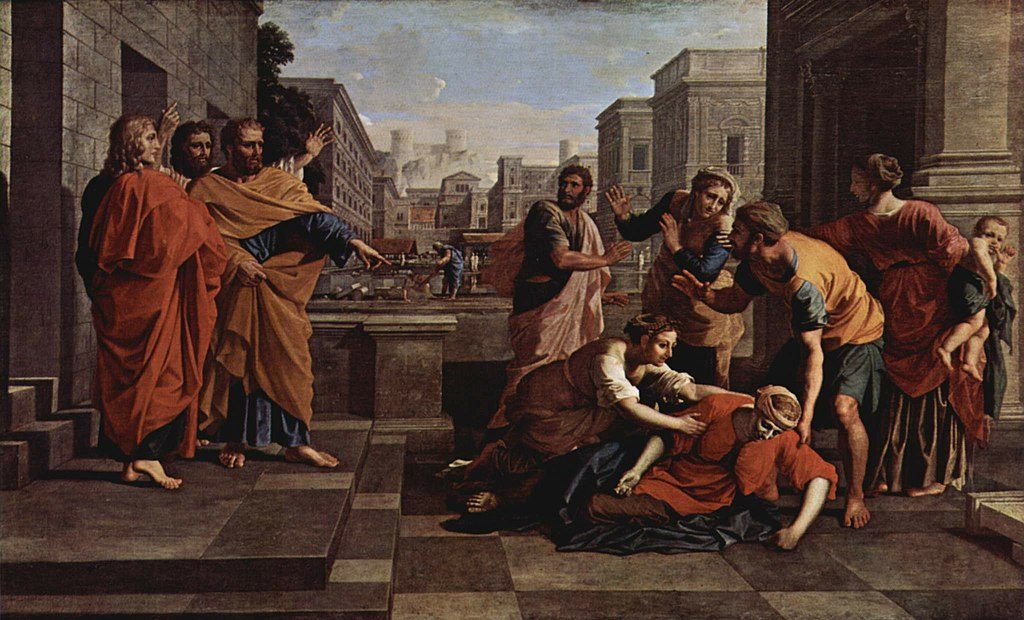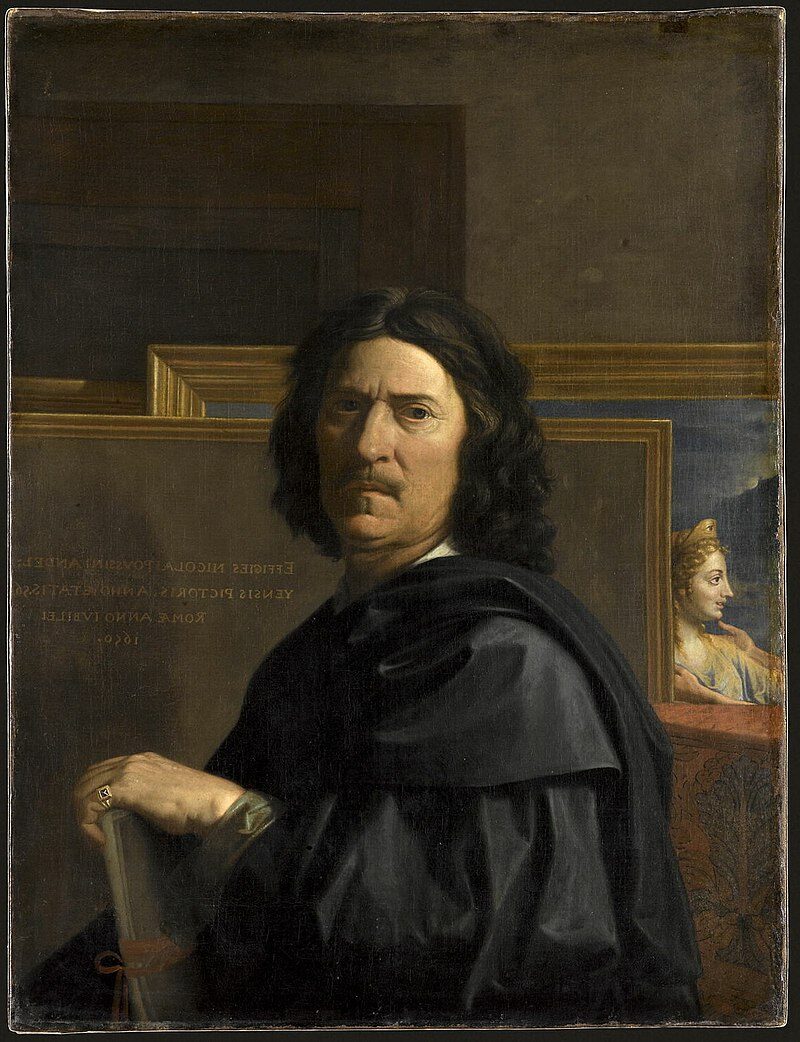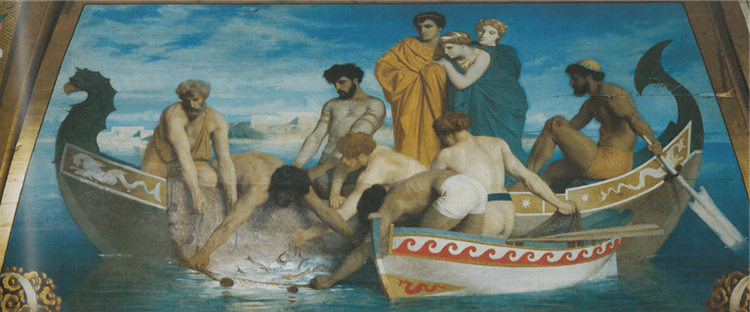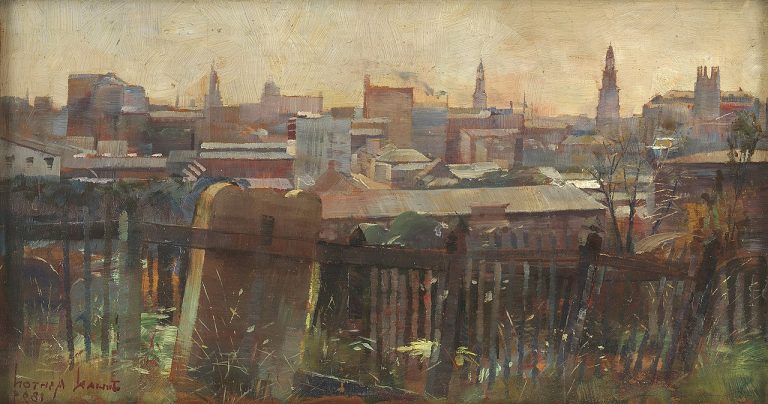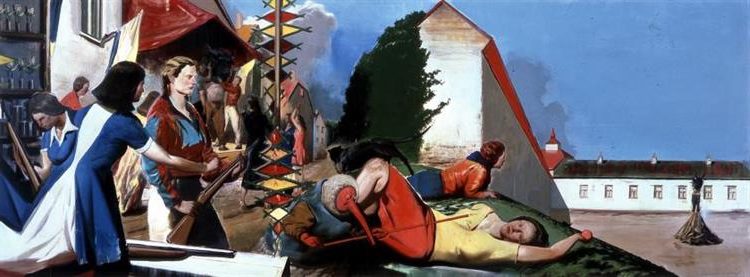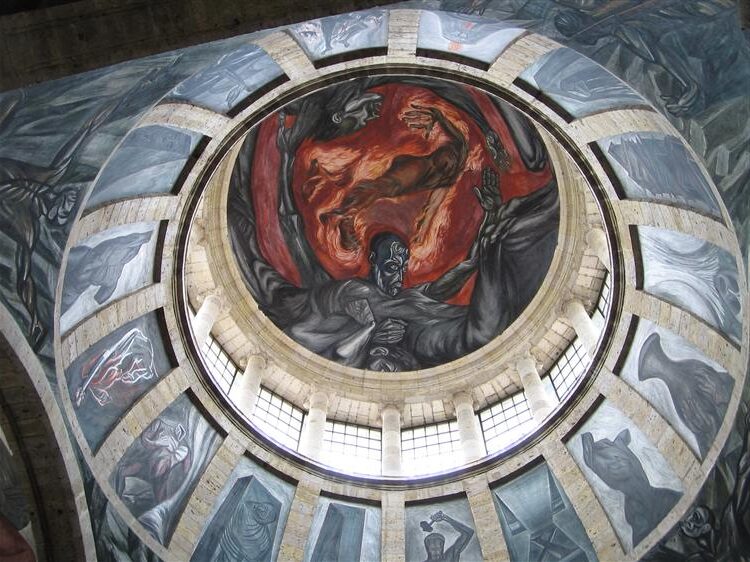Nicolas Poussin: Painter of Classical Masterpieces in 17th Century France
Born: June 1594, near Les Andelys, Normandy, Kingdom of France
Death: 19 November 1665, Rome, Papal States
Art Movement: Classicism, Baroque
Nationalité : Français
Influenced By: Raffaello Sanzio
Nicolas Poussin: Painter of Classical Masterpieces in 17th Century France
Life and Career of Nicolas Poussin
Nicolas Poussin’s journey from rural France to becoming one of the most influential classical painters spanned several decades and two countries. His artistic development was shaped by his time in Rome, where he spent most of his working life, and his brief return to France in service to the king.
Début de la vie et influences
Nicolas Poussin was born in 1594 in Les Andelys, Normandy, a region in northern France. His artistic training began locally under Quentin Varin, who recognized the young Poussin’s talent and provided his first formal instruction in painting techniques.
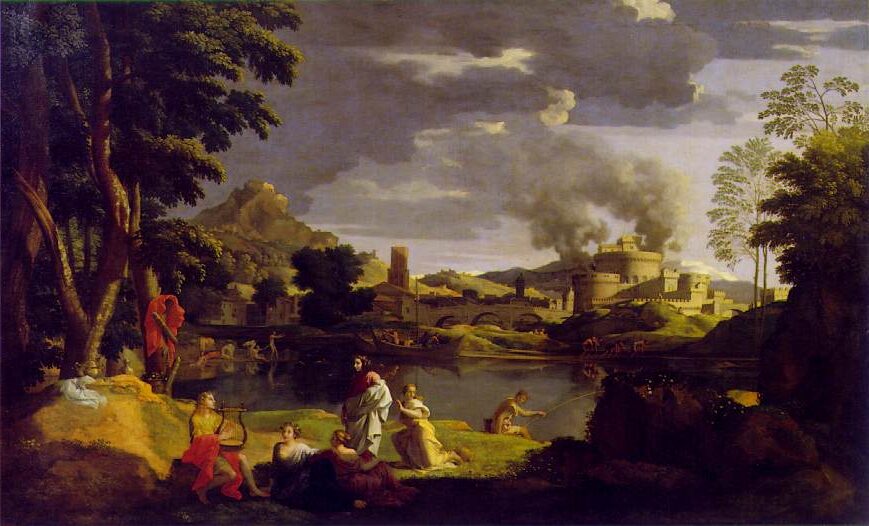
Landscape with Orpheus and Eurydice, 1650–51 by Nicolas Poussin
In 1612, Poussin moved to Paris to further his artistic education. The French capital exposed him to Renaissance masterpieces in royal collections and introduced him to potential patrons. Despite these opportunities, Poussin struggled to establish himself in Paris.
His early style was influenced by both French traditions and the Italian Renaissance works he studied through prints and copies. After several unsuccessful attempts, Poussin finally managed to journey to Rome in 1624, traveling via Venice where he absorbed the rich colors of Venetian painting.
Poussin’s Time in Rome
Rome transformed Poussin both personally and artistically. The eternal city offered him direct access to ancient sculptures, Renaissance masterpieces, and a community of artists from across Europe.
Poussin quickly gained important patrons, including the scholar Cassiano dal Pozzo, who commissioned works and introduced him to Rome’s intellectual circles. These connections helped Poussin secure commissions despite initial hardships including illness.
By the 1630s, Poussin had developed his distinctive style classique characterized by rational composition, clarity, and emotional restraint. His paintings of mythological and biblical subjects demonstrated his deep knowledge of ancient literature and philosophy.
Rome became Poussin’s true home. He married Anne-Marie Dughet in 1630 and immersed himself in studying antiquities. His reputation grew steadily, attracting attention from French collectors and eventually reaching the French court.
Service to Louis XIII and Return to Rome
In 1640, Poussin received an invitation from Cardinal Richelieu to return to France and serve as First Painter to King Louis XIII. Despite his reluctance to leave Rome, Poussin felt obligated to accept this prestigious position.

Blind Orion Searching for the Rising Sun, 1658 by Nicolas Poussin
Poussin arrived in Paris in December 1640 to a warm welcome. He was assigned major decorative projects for royal residences and received a substantial salary. However, court politics and artistic rivalries quickly made him uncomfortable.
The rigid demands of the French court conflicted with Poussin’s independent working methods. He disliked the collaborative nature of decorative projects and struggled with the expectations of portraiture that came with his royal position.
After less than two years, Poussin negotiated permission to return to Rome, ostensibly to fetch his wife but with the clear intention of remaining there. He returned to Rome in 1642 and remained there until his death in 1665, continuing to paint masterpieces that would influence generations of artists including Jacques-Louis David and Jean-Auguste-Dominique Ingres.
Style artistique et philosophie
Nicolas Poussin developed a distinctive artistic approach that combined classical ideals with emotional depth. His work represents a thoughtful balance between intellectual rigor and poetic expression, setting him apart from many of his contemporaries.
Classicism and Baroque Influences
Poussin’s style emerged at the intersection of Baroque drama and classical restraint. While he lived during the Baroque period, he rejected its typical theatrical excess in favor of more measured compositions. By the mid-1630s, he had developed a serene, classical style heavily influenced by Raphael and ancient Roman art.

The Judgement of Solomon, 1649 by Nicolas Poussin
Unlike his contemporaries who emphasized emotional intensity, Poussin sought intellectual clarity. He studied the works of Domenichino and classical sculptures, incorporating their balanced proportions and dignified poses into his paintings.
Despite working in Rome, Poussin maintained a distinctly French intellectual approach. His art became the foundation for French Classicism, emphasizing order and rationality rather than the sensual qualities found in Titian’s work.
Use of Color and Clarity
Poussin employed color with deliberate precision rather than emotional exuberance. He favored clear, distinct hues arranged in harmonious relationships that enhanced the structural coherence of his compositions.
His paintings feature sharp outlines and carefully modeled forms. This clarity reflected his belief that art should communicate ideas with precision and without ambiguity.
Unlike the loose brushwork of Venetian painters, Poussin applied paint with controlled, even strokes. This technique created smooth surfaces that directed attention to the intellectual content rather than the physical qualities of the paint.
His landscapes show this same clarity, with each element precisely placed and bathed in a crystalline light that reveals form and structure.
Thematic Emphasis on Logic and Order
Poussin’s subjects—drawn from the Bible, classical mythology, and ancient history—served as vehicles for exploring rational concepts. He treated Ovid’s Metamorphoses and other classical texts as sources for intellectual meditations rather than merely decorative scenes.

Landscape with the Ashes of Phocion, 1648 by Nicolas Poussin
Each painting represented a carefully orchestrated composition where every element had its logical place. Figures were arranged in geometric patterns that guided the viewer’s eye and reinforced the narrative’s meaning.
Poussin believed art should appeal to the mind rather than simply please the eye. This philosophical approach influenced later artists like Paul Cézanne, who admired Poussin’s logical organization of visual elements.
Religious themes in his work emphasize moral lessons and rational faith rather than mystical experiences. Even in depicting dramatic moments, Poussin maintained a sense of order and emotional restraint.
Œuvres notables et héritage
Nicolas Poussin created masterpieces that continue to influence art today. His methodical approach to composition and storytelling through classical themes established him as one of the most significant painters of the 17th century.
Key Paintings and Collections
Poussin’s “The Rape of the Sabine Women” showcases his ability to capture dramatic narrative through carefully arranged figures and classical architecture. This work exemplifies his commitment to historical accuracy and emotional depth.

The Rape of the Sabine Women, c. 1638 by Nicolas Poussin
“The Death of Germanicus” (1627) remains one of his most celebrated paintings, displaying his mastery of depicting grief through restrained emotion and precise composition. It hangs in the Minneapolis Institute of Art.
His series “Seven Sacraments” presents religious ceremonies with dignified classicism. These works appear in major institutions including the National Gallery in London and the Louvre Museum in Paris.
“The Arcadian Shepherds” (also known as “Et in Arcadia Ego”) exists in multiple versions, with the most famous housed in the Louvre. This contemplative work shows shepherds discovering a tomb in an idyllic landscape.
Influence sur les générations futures
Poussin’s methodical approach to composition profoundly influenced later artists. Paul Cézanne notably declared, “I want to make of Impressionism something solid and lasting like the art in museums.”
His landscape innovations, particularly his structured approach to depicting nature, impacted Claude Lorrain and established the classical landscape tradition. This influence extended through centuries of European painting.
French Academic painters of the 18th and 19th centuries revered Poussin as the epitome of rational, intellectual art. They studied his works extensively at the French Academy.
British collectors and artists particularly championed Poussin, with the Dulwich Picture Gallery and National Gallery in London acquiring significant collections of his paintings, ensuring his legacy in England.
Preservation and Exhibitions
The Louvre Museum holds the world’s largest collection of Poussin’s works, with over 40 paintings that are regularly displayed in dedicated galleries. These works receive careful conservation treatment to preserve their subtle color relationships.
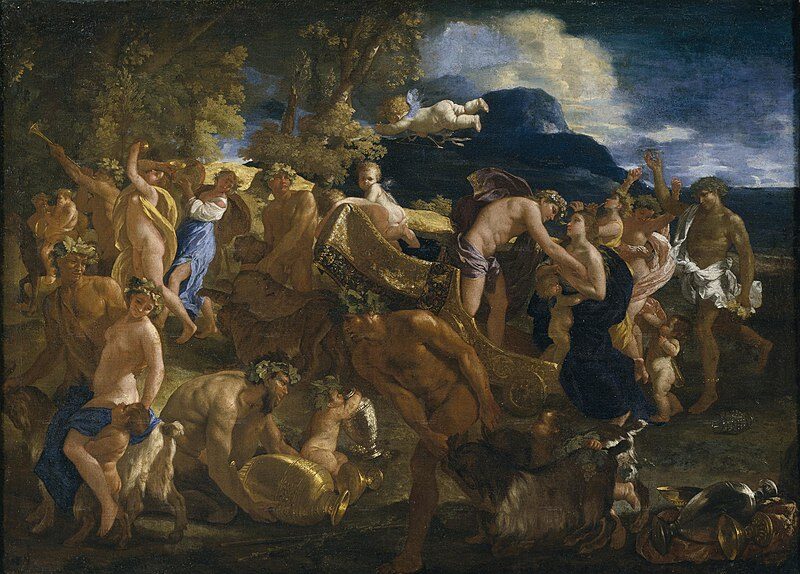
Bacchanale or Bacchus and Ariadne, 1624–1625 by Nicolas Poussin
Major retrospectives have been organized at institutions including the Metropolitan Museum of Art in New York (1994), the Royal Academy in London (1995), and the Grand Palais in Paris (2015). These exhibitions introduced his work to new generations.
Digital preservation efforts now make Poussin’s complete works accessible online. High-resolution imaging reveals his meticulous working methods and the subtle underdrawings beneath his final compositions.
His tomb at San Lorenzo in Lucina in Rome has become a pilgrimage site for art historians and painters seeking to honor his contributions to Western art history.
Questions fréquemment posées
Nicolas Poussin developed unique artistic approaches that shaped both French and Italian art. His classical style, philosophical depth, and innovative techniques established him as a foundational figure en histoire de l'art.
What is the significance of Nicolas Poussin’s contribution to classical painting?
Poussin is considered the founder of the French Classical tradition in painting. His meticulous compositions featured balanced arrangements and clear narratives.
He spent most of his working life in Rome, where he developed a distinctly classical approach. This style became a cornerstone of French art education for centuries.
Poussin’s work represented a rational approach to painting. He emphasized order, clarity, and intellectual content over mere decorative appeal.
How did Nicolas Poussin’s techniques influence Baroque art?
While Poussin worked during the Baroque period, his style offered a more restrained alternative to the emotional exuberance typical of the era. His approach emphasized intellectual clarity rather than dramatic movement.
His techniques focused on careful composition and color harmony. These principles influenced generations of painters who sought balance in their work.
Poussin’s disciplined method contrasted with the theatrical style of many Baroque artists. This provided an important counterpoint that enriched the artistic vocabulary of the period.
Can you explain Nicolas Poussin’s ‘theory of modes’ and its impact on art history?
Poussin developed a “theory of modes” inspired by ancient Greek musical theory. He believed different compositional approaches could evoke specific emotional responses.
This theory suggested paintings should use appropriate combinations of subject, color, and composition to communicate particular moods. Each “mode” was designed to produce a specific emotional effect.
His systematic approach influenced how later artists thought about composition. It established the idea that paintings should be constructed thoughtfully to achieve desired psychological impacts.
In what ways did Nicolas Poussin’s artworks embody the ideals of humanism?
Poussin’s paintings frequently featured classical themes that celebrated human reason and virtue. His work reflected the humanist interest in ancient Greek and Roman culture.
He portrayed human figures with dignity and intellectual depth. Characters in his paintings often demonstrate moral choice and philosophical contemplation.
His compositions emphasized harmony, proportion, and balance. These qualities mirrored humanist ideals of order and rational understanding in both art and society.
What role did mythological themes play in Nicolas Poussin’s paintings?
Mythological subjects formed a significant portion of Poussin’s body of work. He used these stories to explore complex human emotions and moral dilemmas.
His mythological paintings were not merely decorative but served as vehicles for philosophical ideas. Each scene was carefully constructed to communicate deeper meanings.
Poussin often selected lesser-known moments from myths that offered opportunities for psychological insight. This approach demonstrated his interest in the intellectual aspects of storytelling.
How did Nicolas Poussin incorporate philosophical ideas into his artwork?
Poussin was known for his intellectual approach to painting. He incorporated Stoic philosophy and classical thought into his compositional decisions.
His paintings often present moral lessons or philosophical concepts through narrative scenes. Viewers were invited to contemplate the deeper meanings behind the visual elements.
Poussin believed art should appeal to the mind as well as the eye. This conviction led him to create works that function as visual essays on human nature, virtue, and the relationship between people and their environment.

